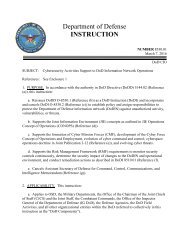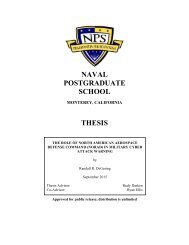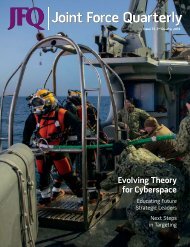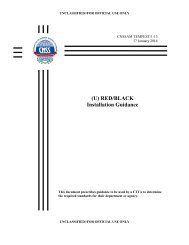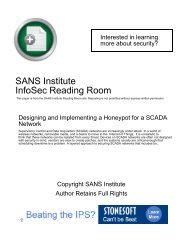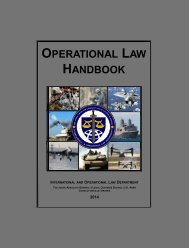jko-catalog-sep-2012
jko-catalog-sep-2012
jko-catalog-sep-2012
You also want an ePaper? Increase the reach of your titles
YUMPU automatically turns print PDFs into web optimized ePapers that Google loves.
JKO Course Descriptions<br />
as well as our own. This course provides a fundamental understanding of interorganizational and interagency coordination<br />
and multinational operations to the Joint Force Commander (JFC) and staff in order to organize the Joint Task Force (JTF) and<br />
execute the mission in a manner which ensures unity of effort. Essential considerations are presented for coordination, cooperation,<br />
and teamwork among other government agencies (OGAs)-of the US Government (USG), non-governmental organizations<br />
(NGOs), intergovernmental organizations (IGOs), and Combatant Commands (COCOMs) involved in joint operations.<br />
1 hour(s)<br />
At the completion of this course you will be able to:<br />
• Describe interorganizational coordination within the context of Department of Defense (DOD) involvement<br />
• Describe interagency coordination within the context of DOD involvement<br />
• Describe multinational operations with the structure of a coalition or alliance<br />
JFC 100: Module 5 Joint Operation Planning J3OP-US1145* N<br />
The successful conduct of military operations relies on comprehensive and thorough planning. More specifically, joint operation<br />
planning relies on procedures in the Joint Operation Planning and Execution System (JOPES), joint operation planning process<br />
(JOPP), and Adaptive Planning and Execution (APEX) system. JOPES, JOPP, and APEX share the same basic approach and<br />
problem-solving elements, such as mission analysis and course of action development. JOPP applies to deliberate planning<br />
and crisis action planning (CAP) in APEX and JOPES and can be viewed as complementing the overall approach to planning.<br />
This course presents an overview of joint operation planning conducted by a joint force commander (JFC) and staff. Joint planning<br />
is currently in the process of adopting an adaptive planning framework. Thus it is important to know the basics of the original<br />
JOPES and the new APEX System. Other topics include key steps of JOPP and the integration of deployment planning into<br />
this process. 2 hour(s)<br />
Upon completion of this module, you will be able to:<br />
• Identify the basic tenets of operational-level planning<br />
• Describe joint force command (JFC) integration into the Joint Operation Planning and Execution System (JOPES) proce<br />
dures<br />
• Describe how operational art and operational design are used to form a complete understanding of the operational<br />
environment and to craft a concept of the operation.<br />
• Describe each step of the joint operation planning process, deliberate planning, campaign plans, and contingency<br />
plans.<br />
• Define the steps in the crisis action planning process.<br />
• Identify the joint force commander's role in operational-level planning<br />
• Recall how joint planners utilize APEX to formulate and execute plans according to assessed operational require<br />
ments.<br />
JFC 200 Module 8: Intelligence Operations at the Operational Level J3OP-US1156* N,S<br />
This course introduces the challenges and best practices of joint intelligence operations across all levels of war using a variety<br />
of traditional and scenario-based instructional methods. The content presented in this course is based on the Insights and<br />
Best Practices paper on Intelligence Operations at the Operational Level. This course introduces challenges and best practices<br />
of joint intelligence operations, including: 2 hour(s)<br />
• complex operational environments<br />
• intelligence capabilities<br />
• multi-dimensional, holistic view of the environment<br />
• non-traditional information sources<br />
JFC 200: Module 3 Interorganizational Coordination J3OP-US1151* N<br />
This course describes insights and best practices to interorganizational coordination specifically correlating to narrowing the<br />
coordination void, organizational responsibilities, and building relationships and inclusion. Examples from the Operation UNI-<br />
FIED RESPONSE JCOA briefing will be used to exemplify and reinforce the objectives of this course. 1 hour(s)<br />
Upon completion of this module, you will be able to:<br />
• Describe the improvement of the communication void at the operational level<br />
• Describe the reasons why the military would play a supporting role in an operation<br />
• Describe the importance of the whole of government approach<br />
• Describe the importance of understanding the best practices within your organization and other organizations in rela<br />
tion to LNOs<br />
• Describe the challenges and best practices to organization responsibilities and authority by use of C5 thinking when<br />
working with partners and stakeholders<br />
* Indicates new courses added to the JKO LCMS after July 2011. The “*” is not a part of the actual course number.<br />
108




